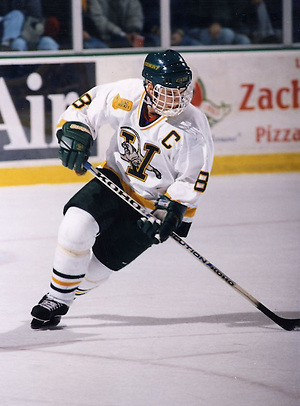Seven years ago, when Martin St. Louis sat in meetings about a bidding process that could potentially bring a major college hockey event to Florida, he was hopeful for the future.
Tampa, Fla., the city where St. Louis played professional hockey, had a shot at hosting the final three games of the NCAA Division I college hockey tournament. And St. Louis, a former college hockey player, could potentially have a role in that process.
But like any NHL player, he also had some reservations. He asked himself: Will I be part of the Tampa Bay Lightning in seven years? Will I be able to see this come to fruition in the town where I live and work?
“I went to the meetings but I didn’t have input as far as the landscape of [the Frozen Four in Tampa],” said St. Louis, a right wing with the Lightning. “But it’s weird to think that seven years ago, we had that meeting and tried to get the Frozen Four here. Time flies.
“But it was an honor to be part of it. To see something like this happen now, it’s wild.”
In his 10th season with the Lightning (not including the 2004-05 lockout year), St. Louis has seen the appeal of hockey grow in the Tampa-St. Petersburg region. The Lightning have made five playoff appearances in that time, won the 2004 Stanley Cup and reached the 2011 Eastern Conference finals. Furthermore, the organization includes three of the NHL’s marquee players in St. Louis, Steven Stamkos and Vincent Lecavalier.
But April 5 and 7, St. Louis’ home arena — the Tampa Bay Times Forum — will host the Frozen Four, Division I hockey’s semifinals and championship game. It will be the first time since 1999 that a city south of the 36th parallel will host the national semifinals and championship, and it’s another change in the landscape of college hockey’s culture.
The scope of the Frozen Four itself has changed for players, for teams and for fans. When St. Louis played in the 1996 Frozen Four with Vermont, he enjoyed the experience of playing in the championship atmosphere. However, St. Louis also remembers the controversial ending for the Catamounts on a swampy ice surface in Cincinnati’s Riverfront Coliseum (now named U.S. Bank Arena). An apparent hand pass set up Chad Remackel’s goal at 9:32 of the second overtime to help Colorado College defeat Vermont 4-3 and reach the national title game against Michigan.
In the 15 years since that weekend in Ohio, St. Louis admits he hasn’t paid much attention to the locations of the Frozen Four each year. But he’s seen the college game change.
“When I played, it was four leagues: the ECAC, the WCHA, Hockey East, the CCHA and maybe an independent team,” St. Louis said. “It’s expanded, and that’s how I see college hockey has changed. But in terms of the Frozen Four experience, I want to see how that changes.”
At this year’s Frozen Four, there will be a small group of fans who make the annual trip to each Frozen Four, including several who live in Florida.

Tom Bore has gone to every Frozen Four since 1988, when Lake Superior State won the national title, 11 years before the NCAA renamed the semifinals and championship round of the national tournament the Frozen Four in 1999, when Maine, New Hampshire, Michigan State and Boston College met in Anaheim, Calif.
This year, he and his wife, Diane, will travel about 180 miles round trip from The Villages, Fla., to Tampa for each of the three Frozen Four games.
“I look forward to seeing the same friends each year, people from Alaska and Michigan,” Bore said. “It’s the fun of it. Hockey East has dominated in the Frozen Four for a bit, with Boston College and BU winning.”
And, Bore laughed and added, when the big schools get beat, “everyone is happy!”
But at the same time, fans have seen changes over the course of the years. Since 1999, Pat Bearden has traveled from San Juan Capistrano, Calif., to each Frozen Four for the past 12 years. Twelve years ago, she paid $99 for a ticket to the national semifinals and championships in Anaheim. This year, Bearden paid $201 a ticket for the three Frozen Four games in Tampa.
“That is the thing that is the most noticeable, the price in the tickets,” said Bearden, who buys tickets through the NCAA’s annual lottery. “How affordable is that now for families?”
Furthermore, smaller venues for previous national semifinals and finals in Providence and Lake Placid, N.Y., have given way to professional facilities. NHL arenas have hosted the Frozen Four since 2002, with the exception of two years — 2006 at Milwaukee’s Bradley Center and 2010 at Detroit’s Ford Field.
“Things are different; I don’t know why,” Bore said. “Maybe there’s more of a corporate influence on things. Detroit was bad. The building was made for truck pulls and football.”
After Detroit, the Frozen Four returned to NHL facilities — including the building that continues to be St. Louis’ home.
“Being in Tampa, for me, it’s mission accomplished,” St. Louis said. “The people that were involved who worked really hard to make this happen, it means a lot. And it gives the chance for Tampa fans to see college hockey, which for some of them, they probably never have.”


